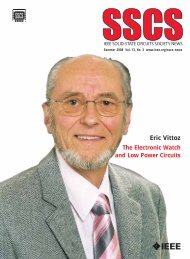The Impact of Dennard's Scaling Theory - IEEE
The Impact of Dennard's Scaling Theory - IEEE
The Impact of Dennard's Scaling Theory - IEEE
- TAGS
- scaling
- www.ieee.org
You also want an ePaper? Increase the reach of your titles
YUMPU automatically turns print PDFs into web optimized ePapers that Google loves.
CONFERENCES<br />
<strong>The</strong> Second A-SSCC Considers Challenges for the e-Life<br />
Gathered for the opening plenary <strong>of</strong> the A-SSCC in Hangzhou are(l-r) Pr<strong>of</strong><br />
Tadahiro Kuroda <strong>of</strong> Keo University and Chair <strong>of</strong> the Invited Program Committee,<br />
Nicky Lu <strong>of</strong> Etron Technology and Chair <strong>of</strong> Conference Industry Program,<br />
Richard C. Jaeger <strong>of</strong> Auburn University and President SSCS, Richard Chang, the<br />
President <strong>of</strong> Semiconductor Manufacturing International Corporation and<br />
Chair <strong>of</strong> the Technical Program, and C.K. Wang <strong>of</strong> National Taiwan University<br />
and Conference Steering Committee Chair.<br />
<strong>The</strong> successful Asian Solid-<br />
State Circuits Conference in<br />
November, 2006 in Hangzhou,<br />
China was organized with a core <strong>of</strong><br />
107 papers selected by an international<br />
program committee. <strong>The</strong><br />
acceptance rate was 32% with a conference<br />
audience <strong>of</strong> 260 registered<br />
attendees. CK Wang, the Steering<br />
Committee chair <strong>of</strong> A-SSCC, reported<br />
that the conference was quite<br />
successful both “in terms <strong>of</strong> paper<br />
quality and foreign attendees with<br />
82 from Japan, 48 from Taiwan, and<br />
39 from Korea.” Pr<strong>of</strong> Wei <strong>of</strong><br />
Tsinghua University and local host<br />
felt that it was the first high quality<br />
and world class conference held in<br />
China. <strong>The</strong> tutorials that began the<br />
conference were open at no cost to<br />
any students in attendance.<br />
Three papers, announced as<br />
winners <strong>of</strong> the Student Design<br />
Contest, were awarded at A-SSCC.<br />
<strong>The</strong> competition, in cooperation<br />
with the ISSCC, includes transportation<br />
for the lead student<br />
researcher to the ISSCC February<br />
2007 in San Francisco, for the<br />
papers to be included in the<br />
ISSCC poster session. <strong>The</strong> A-SSCC<br />
student design contest finalists<br />
are selected from regular accepted<br />
papers that are authored by<br />
students. Only the realized<br />
designs, not simply simulations,<br />
are selected and invited to<br />
demonstrate the operation <strong>of</strong> the<br />
chips on-site. It is not a contest<br />
with a single specification or<br />
application, but rather a contest<br />
for the completeness <strong>of</strong> develop-<br />
ment and demonstration <strong>of</strong> the<br />
fabricated integrated circuit. <strong>The</strong><br />
papers, co-authors, and abstracts<br />
are listed below.<br />
(I) A TCAM-based Periodic Event<br />
Generator for Multi-Node Management<br />
in the Body Sensor Network<br />
Sungdae Choi, Kyomin Sohn, Jooyoung<br />
Kim, Jerald Yoo and Hoi-Jun<br />
Yoo (KAIST)<br />
A low-power periodic events generation<br />
is essential for a node controller<br />
in the network system with<br />
centralized control and the timer<br />
interrupt generation for various<br />
devices in a CPU. <strong>The</strong> proposed<br />
TCAM-based periodic event generator<br />
manages the issuing events<br />
with the programmed value and<br />
the number <strong>of</strong> the events is equal<br />
to the number <strong>of</strong> the word line <strong>of</strong><br />
the TCAM block. <strong>The</strong> NAND-type<br />
TCAM cell operates with as low as<br />
0.6V supply voltage and the lowenergy<br />
match line precharge<br />
reduces the search line transition<br />
which causes most <strong>of</strong> the search<br />
energy dissipation. <strong>The</strong> implemented<br />
event generator consumes<br />
184-nJ energy to schedule events<br />
<strong>of</strong> 255 nodes for 24-hours, which is<br />
less than 10% <strong>of</strong> energy consumption<br />
<strong>of</strong> conventional hardware<br />
timer blocks.<br />
Winners <strong>of</strong> the A-SSCC 2006 student design contest were (from left) first, Sungdae<br />
Choi <strong>of</strong> KAIST, Seoul, second Mr. Yusaku Ito <strong>of</strong> the Tokyo Institute <strong>of</strong> Technology,<br />
and third Mr. Simone Gambini Simone Gambini and Jan Rabaey <strong>of</strong> the<br />
University <strong>of</strong> California at Berkeley. Presenting the awards is Pr<strong>of</strong>. Hoi-Jun<br />
Yoo, Chair <strong>of</strong> Design Contest.<br />
74 <strong>IEEE</strong> SSCS NEWSLETTER Winter 2007




